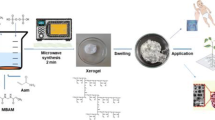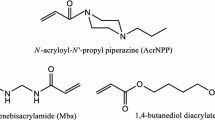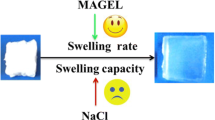Abstract
In the present investigation, a series of hydrogels based on poly (AM-co-AA-co-HEA) from the constant weight ratio (1/1/1) of acrylamide (AM), acrylic acid (AA), and hydroxy ethyl acrylate (HEA) monomers were synthesized by solution polymerization to optimize the reaction conditions. The reaction conditions were optimized by varying the reaction temperature, reaction time, crosslinker and initiator concentration, and amount of solvent. At optimized reaction conditions, two different sets of hydrogels were synthesized by varying the concentrations of cross-linker (glycidyl methacrylate, GMA) from 1 to 4 % and initiator (ammonium per sulphate, APS) from 1 to 4 %, to study the effects of crosslinker variation as well as initiator variation on swelling ratio by Flory’s equations. The three mathematical models (early time, late time and etters model) were fitted on experimental swelling data to investigate the entire swelling profile of all the hydrogels prepared with various amounts of GMA and APS content. Values of swelling transport exponents showed that the swelling mechanism was shifted from diffusion to relaxation controlled in case of increasing APS content, while only diffusion mechanism was followed for increasing GMA content. The proportionality constant (k) was calculated by two different models (1) power law and (2) Baker and Lonsdale to confirm the validity of early-time model fitting on experimental swelling data.








Similar content being viewed by others
References
Buchholz FL, Graham AT (1997) Modern superabsorbent polymer technology. Wiley, New York
Imperiyka M, Ahmad A, Hanifah SA, Rahman MYA (2013) Potential of UV-curable poly(glycidyl methacrylate-co-ethyl methacrylate)- based solid polymer electrolyte for lithium ion battery application. Int J Electrochem Sci 8:10932–10945
Chae KH, Song HB (1998) Crosslinking reaction of glycidyl methacrylate copolymers containing oxime-urethane groups using photogenerated pendant amines. Polym Bull 40:667–674
Okay O (2000) Macroporous copolymer networks. Prog Polym Sci 25:711–779
Saraydın D, Karadağ E, Işıkver Y, Şahiner N, Güven O (2004) The influence of preparation methods on the swelling and network properties of acrylamide hydrogels with crosslinkers. J Macromol Sci A Pure Appl Chem 41:419–431
Mullarney MP, Seery TAP, Weiss RA (2006) Drug diffusion in hydrophobically modified N,N-dimethylacrylamide hydrogels. Polymer 47:3845–3855
Awasthi S, Singhal R (2012) A mathematical study on effect of 2-hydroxyl ethyl acrylate on controlled drug diffusion from smart hydrogels based on poly(acrylamide-co-hydroxy ethyl acrylate-co-acrylic acid). J Macromol Sci A Pure Appl Chem 49:397–413
Vazquez B, Roman JS, Peniche C, Cohen ME (1997) Polymeric hydrophilic hydrogel with flexible hydrophobic chains; control of hydration and interactions with water molecules. Macromolecules 30:8440–8446
Park K, Shalaby WSW, Park H (1993) Biodegradable hydrogels for drug delivery. Lancaster, Technomic
Flory PJ (1953) Principles of polymer chemistry. Cornell University Press, Ithaca
Crank J (1975) The mathematics of diffusion, 2nd edn. Oxford, Oxford University Press
Hopfenberg HB, Frisch HL (1969) Transport of organic micromolecules in amorphous polymers. J Polym Sci Polym Lett 7:405–409
Barens AR, Hofenberg HB (1978) Diffusion and relaxation in glassy polymer powers. 2. Separation and diffusion and relaxation parameter. Polymer 19:489–496
Ritger PL, Peppas NA (1987) A simple equation for description of solute release. I. Fickian and non-Fickian release from non-swellable devices in the form of slabs-spheres cylinders or discs. J Control Release 5:23–36
Peppas NA, Franson NM (1983) The swelling interface number as a criterion for prediction of diffusional solute release mechanisms in swellable polymers. J Polym Sci Polym Phys Ed 21:983–997
Etters JN (1980) Diffusion equation made easy. Text Chem Color 12:140–145
Enscore DJ, Hopfenberg HB, Stannett VT (1977) Effect of particle size on the mechanism controlling n-hexane sorption in glassy polystyrene microspheres. Polymer 18:793–800
Peppas NA, Lustig CSR (1984) Drugs and carriers for biologically active materials. Academy of Sciences, New York, p. 26
Wu S, Li H, Chen JP (2004) Modeling investigation of volume variation kinetics of fast response hydrogels. J Macromol Sci C Polym Rev 44:113–130
Tanchak OM, Barrett C (2004) Swelling dynamics of multilayer films of weak polyelectrolytes. Chem Mater 16:2734–2739
Baker RW, Lonsedale HK (1974) Controlled release: mechanisms and rates. In: Tanquarry AC, Lacey RE (eds) Controlled release of biologically active agents. Plenum Press, New York, pp. 15–71
Author information
Authors and Affiliations
Corresponding author
Rights and permissions
About this article
Cite this article
Awasthi, S., Singhal, R. Mathematical modeling for the prediction of the overall swelling profile from poly (AM-co-AA-co-HEA) hydrogels: effect of glycidyl methacrylate and ammonium per sulphate. Int J Plast Technol 19, 241–262 (2015). https://doi.org/10.1007/s12588-015-9124-1
Received:
Accepted:
Published:
Issue Date:
DOI: https://doi.org/10.1007/s12588-015-9124-1




